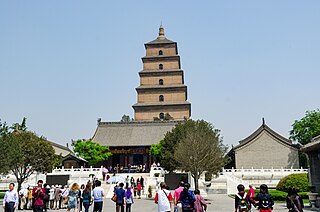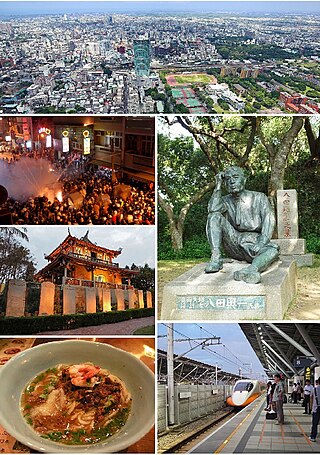
Bursa, historically known as Prusa, is a city in northwestern Turkey and the administrative center of Bursa Province. The fourth-most populous city in Turkey and second-most populous in the Marmara Region, Bursa is one of the industrial centers of the country. Most of Turkey's automotive production takes place in Bursa. As of 2019, the Metropolitan Province was home to 3,056,120 inhabitants, 2,161,990 of whom lived in the 3 city urban districts plus Gürsu and Kestel.

Ballarat is a city in the Central Highlands of Victoria, Australia. Ballarat has a population of 119,096 as of March 2024 making it the third-largest urban inland city in Australia and the third-largest city in Victoria.

Kyoto, officially Kyoto City, is the capital city of Kyoto Prefecture in the Kansai region of Japan's largest and most populous island of Honshu. As of 2020, the city had a population of 1.46 million, making it the ninth-most populous city in Japan. More than half (56.8%) of Kyoto Prefecture's population resides in the city. The city is the cultural anchor of the substantially larger Greater Kyoto, a metropolitan statistical area (MSA) home to a census-estimated 3.8 million people. It is also part of the even larger Keihanshin metropolitan area, along with Osaka and Kobe.

Xi'an is the capital of Shaanxi Province. A sub-provincial city on the Guanzhong Plain, the city is the third most populous city in Western China, after Chongqing and Chengdu, as well as the most populous city in Northwest China. Its total population was 12,952,907 as of the 2020 census. The total urban population was 9.28 million.

The Kansai region or the Kinki region lies in the southern-central region of Japan's main island Honshū. The region includes the prefectures of Nara, Wakayama, Kyoto, Osaka, Hyōgo and Shiga, often also Mie, sometimes Fukui, Tokushima and Tottori. The metropolitan region of Osaka, Kobe and Kyoto is the second-most populated in Japan after the Greater Tokyo Area.

Konya is a major city in central Turkey, on the southwestern edge of the Central Anatolian Plateau, and is the capital of Konya Province. During antiquity and into Seljuk times it was known as Iconium. In 19th-century accounts of the city in English its name is usually spelt Konia or Koniah. In the late medieval period, Konya was the capital of the Seljuk Turks' Sultanate of Rum, from where the sultans ruled over Anatolia.

Obama is a city located in Fukui Prefecture, Japan. As of 1 August 2018, the city had an estimated population of 29,435 in 12,057 households and a population density of 240 persons per km2. The total area of the city was 233.09 square kilometres (90.00 sq mi). Obama gained publicity in the United States and elsewhere in 2008, as it shares its name with Barack Obama, who was running for, and later became, President of the United States.

Gyeongju, historically known as Seorabeol, is a coastal city in the far southeastern corner of North Gyeongsang Province, South Korea. It is the second largest city by area in the province after Andong, covering 1,324 km2 (511 sq mi) with a population of 264,091 people as of December 2012. Gyeongju is 370 km (230 mi) southeast of Seoul, and 55 km (34 mi) east of Daegu. The city borders Cheongdo and Yeongcheon to the west, Ulsan to the south and Pohang to the north, while to the east lies the coast of the Sea of Japan. Numerous low mountains—outliers of the Taebaek range—are scattered around the city.
The Organization of World Heritage Cities (OWHC) is an international non-profit, non-governmental organization of 250 cities in which sites of the UNESCO World Heritage list are located. It was founded in 1993 in Fez, Morocco, during the second International Symposium of World Heritage Cities. The headquarters of the OWHC are located in Quebec City, Quebec, Canada. Altogether the 250 member cities of the OWHC have a population of more than 130 million.
Tourism in Gyeongju is a major industry and defining feature of Gyeongju, South Korea. Gyeongju is a major cultural site and tourist destination for South Koreans and foreigners with about 8 to 9 million visitors annually. A great deal of this is due to the city's status as a center of Silla heritage, derived from its former role as the capital of that ancient kingdom.

Tourism in South Korea and its industry caters to both foreign and domestic tourists. In 2019, 17.5 million foreign tourists visited South Korea, making it the 20th most visited country in the world. Most non-Korean tourists come from other parts of East Asia such as Japan, mainland China, Taiwan, and Hong Kong. The recent popularity of Korean popular culture, often known as the "Korean Wave", in these countries has increased tourist arrivals.

Tainan, officially Tainan City, is a special municipality in southern Taiwan facing the Taiwan Strait on its western coast. Tainan is the oldest city on the island and commonly called the "prefectural capital" for its over 260 years of history as the capital of Taiwan under the Dutch rule, the Kingdom of Tungning and later Qing dynasty rule until 1887. Tainan's complex history of comebacks, redefinitions and renewals inspired its popular nickname "the Phoenix City". Tainan is classified as a "Sufficiency"-level global city by the Globalization and World Cities Research Network.

The King Sejong Institute is a foundation established by the South Korean government that encourages learning of the Korean language around the world. It was founded in 2007. Its name refers to Sejong the Great, the inventor of the Korean alphabet. As of February 2024, there were 248 King Sejong institutes in 85 countries.

The Globalization and World Cities Research Network (GaWC) is a think tank that studies the relationships between world cities in the context of globalization. It is based in the geography department of Loughborough University in Leicestershire, United Kingdom. GaWC was founded by Peter J. Taylor in 1998. Together with Jon Beaverstock and Richard G. Smith, they create the GaWC's biennial categorization of world cities into "Alpha", "Beta" and "Gamma" tiers, based upon their international connectedness.

The bidding process of UEFA Euro 2016 ended on 28 May 2010 when France was announced to be the host. Four bids came before the deadline, 9 March 2009, which were France, Italy and Turkey as single bids and Norway and Sweden as a joint bid. Norway and Sweden eventually withdrew their bid in December 2009.

The United Nations Climate Change Conferences are yearly conferences held in the framework of the United Nations Framework Convention on Climate Change (UNFCCC). They serve as the formal meeting of the UNFCCC parties – the Conference of the Parties (COP) – to assess progress in dealing with climate change, and beginning in the mid-1990s, to negotiate the Kyoto Protocol to establish legally binding obligations for developed countries to reduce their greenhouse gas emissions. Starting in 2005 the conferences have also served as the "Conference of the Parties Serving as the Meeting of Parties to the Kyoto Protocol" (CMP); also parties to the convention that are not parties to the protocol can participate in protocol-related meetings as observers. From 2011 to 2015 the meetings were used to negotiate the Paris Agreement as part of the Durban platform, which created a general path towards climate action. Any final text of a COP must be agreed by consensus.
Bonnie Fagan, now known as Bonnie Chew, is an activist and advocate for her Indigenous heritage, and has sat on the Victorian Aboriginal Heritage Council.

Silk Roads: The Routes Network of Chang'an-Tian Shan Corridor is a UNESCO World Heritage Site which covers the Chang'an-Tianshan portion of the ancient Silk Road and historical sites along the route. On June 22, 2014, UNESCO designated a 5,000 km stretch of the Silk Road network from Central China to the Zhetysu region of Central Asia as a World Heritage site. The corridor spans China, Kazakhstan and Kyrgyzstan and includes 33 new sites and several previously designated heritage sites.
The Nanjing Historical & Cultural Cities Expo is an international cultural event held in Nanjing, China. The expo is held every two years, and the first one was held in 2004. The meeting is sponsored by the Ministry of Culture, Ministry of Housing and Urban-Rural Development of the People's Republic of China, National Cultural Heritage Administration and the National Commissions for UNESCO, and undertaken by Nanjing Municipal People’s Government, Jiangsu Provincial Department of Culture and Tourism, Jiangsu Provincial Department of Housing and Urban-Rural Development... From the first to the eighth, 276 domestic and foreign cultural city mayors from 74 countries and regions participated. In May 2013, the Organizing Committee of Famous City Club and UNESCO has signed a strategic cooperation agreement.















